The Myth of Medan
Supermassive Games’ latest entry maintains the status quo of janky horror to serviceable effect.
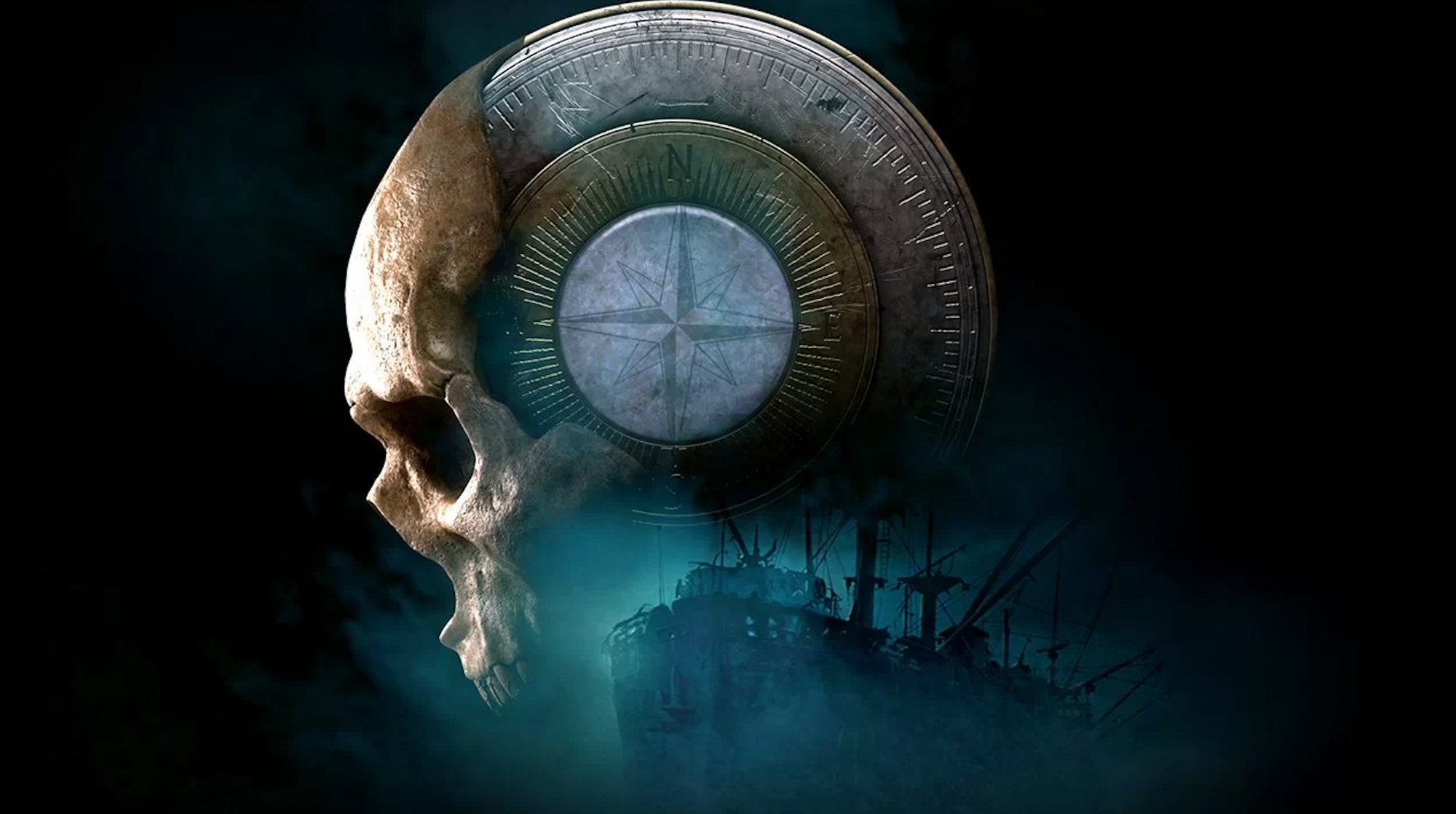
Supermassive Games’ Man of Medan is a game I forgot about often and for which I harbored little in terms of expectations. The only thing it seemed to have going for it was the fact that Shawn Ashmore had taken a vested interest in it and regressed into a role I haven’t seen him in since the early-to-late 2000s. Since its announcement at last year’s E3 event, the radio silent approach to its development was a mite concerning in an industry where developers and publishers are constantly raising the alarm about games that may be a year or years away from going gold and being released to the public.
Before the summer of this year, I would’ve assumed the game was languishing in development hell on account of the obvious shoestring budget that plagued the trailer presentation, but this past E3 event merely reconfirmed it was still alive and primed for a late August release, arriving just in time for the Halloween season of September and October. Fans of Until Dawn watched, primed for what they considered the second coming of the aforementioned game.
As a potential survival-horror game, I’m not sure what else Man of Medan could do that wasn’t nailed by the likes of Until Dawn, and Remedy Entertainment’s Alan Wake far better years before it (speaking strictly regarding western horror games).
So, it helps that Medan — and its narrative universe, The Dark Pictures Anthology — wasn’t promising a sequel to Until Dawn, wasn’t promising bigger production values or even more violin screeching jump scares, but the comfortable familiarity of Supermassive’s standard short story horror found in games like Hidden Agenda, a game that rightly split audiences down the middle.
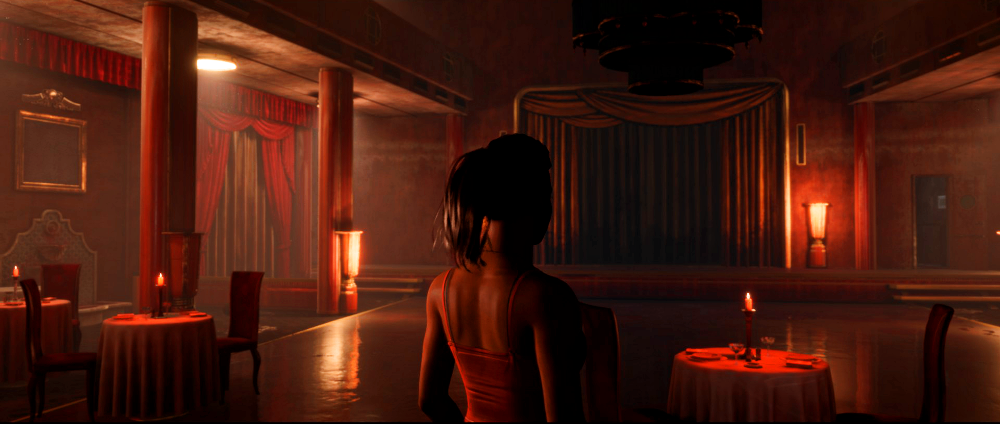
The SS Ourang Medan
The SS Ourang Medan is the stuff of legend, perhaps more so than the myth of the Philadelphia Experiment aboard the USS Eldridge, or the ye olden Mary Celeste and The Ivory Web. It’s a ghost ship that might’ve sailed the seas between the years 1940, 1947, and 1948.
But without physical evidence of its existence (photography, ship records, living crewmen), historians and supernatural enthusiasts would be hard-pressed to claim it existed or didn’t exist at all. The only reason people seem to know about it is thanks to the United States Coast Guard, The Albany Times, and a Dutch publication called Elsevier’s Weekly. The fate of the SS Ourang Medan is covered in The Albany Times’ now-archived newspaper editorial, published October 10, 1948. The Coast Guard’s The Proceedings of the Merchant Marine Council published an editorial on May 9, 1954, that also went into some detail about the ship’s fate and reputation.
The ‘earliest’ reports of the SS Ourang Medan’s existence is credited to the November 1940 newspaper reports from the Daily Mirror, The Yorkshire Evening Post, and The Hampshire Telegraph. The details of the Medan’s fate differ from the well-known accounts of the 1954 and 1948 reports from United States newspapers and were from a man named Silvio Scherli.
While living in Triest, Italy, Scherli met a missionary that stayed on the Marshall Islands when the supposed sole survivor of the Medan (a German sailor) received treatment for malnutrition and dehydration. He was reportedly the only man out of seven who escaped the ship, to make it to shore in the ship’s missing lifeboat. The missionary told Scherli the tale shared with him by the dying sailor.
A Dutch-Indonesian newspaper published three stories from February 3rd, and 28th, to March 13th, 1948. Their source on the Medan was also the Scherli guy and again, the details were different. In the final story published, they stated — in so many words — that they should take their coverage of the Medan with a grain of salt. While this Scherli guy believed the account of the Medan’s sole survivor was legitimate, there was little to say that the tale of the Medan was factual.
Going even deeper into the rabbit hole of Medan’s fate? Some paper archives state the Medan incident was reported as early as the late 1930s. According to the December 29, 1940 issue of a French magazine named Sept-Jours, the Medan’s harrowing incident occurred on November 13, 1939.
Bruh!
Most stories of the Medan maintain there was an S.O.S. distress signal calling for help from nearby ships, that the boat was discovered by other sailors, and the possibility that unsecured chemicals caused the crew’s scared-to-death demise. Anyone who might’ve been able to verify its existence is gone, lost to memory in nameless reference, or never existed.

The finer details of the SS Ourang Medan change enough through accounts. I think it ceases to matter whether the myth that makes it so interesting is fact or fiction. There are theories that its name (which roughly translates to “Man of Medan”, I believe) was falsified to hide the fact that the ship carried deadly chemicals that caused it to explode and sink. The C.I.A. seemed cagey enough to hide their 1953 inquiry into the ship until May 5, 2003, but that means about as much as The Green Book’s Best Picture win.
The SS Baychimo, a former warship turned cargo carrier, reportedly sailed in 1931 without a crew after they abandoned it in icy waters and were last seen in 1963, still going about its merry without a crew to man it. The ship exists, but the nature of its circumstances allows the curious audience to construct a [supernatural] narrative that is far more interesting than any factual details about its current or former status.
The myth of the Medan is the kind of story that should’ve made it onto the big screen when ghost ships were still viable genre fodder for movie-going audiences next to submarines, but it just didn’t.
Four years removed from Until Dawn, an adventure game steeped in the trappings of New Millennium slasher horror made famous by Scream and Screen Gems (a subsidiary of Sony Pictures), Supermassive Games uniquely positioned themselves to make a filmic experience like the story of the Medan a full-fledged interactive journey to remember.
Supermassive’s brand of the ‘Choose Your Own Adventure’ brought something relatively refreshing to the horror genre, expanding the system of determination beyond ‘bad end’, ‘good end’, ‘joke end’ ah-la Silent Hill, or The Blair Witch. The premise is ripe for exploitation under the pretense that disruptive twentysomethings were going to be the spearhead of the tale.
Their later games — The Inpatient and Hidden Agenda — are fairly decent efforts as standalone games for the PlayStation 4’s gimmicky VR and PlayLink tech. Both games, one a horror mystery and the other a police procedural whodunit, are clearer in their story intent, choosing simplicity over convolution. But if anything holds them back, it’s budget and the determined length.
Where Until Dawn feels like a Peter Jackson joint — overlong to the point of indulgence — Hidden Agenda and The Inpatient feel as though they’re scrambling to tell their stories as efficiently as possible because their budget is clearly dictating the length of the game.
Self-consciously brief, the development of their characters and narratives is never present long enough for the player to adjust to the mechanics of the games. Despite their best efforts, everything feels rushed, left hanging, or cut short.
Man of Medan, the first in a series of anthology games, suffers from the same issues the aforementioned two dealt with, but to an even greater degree.
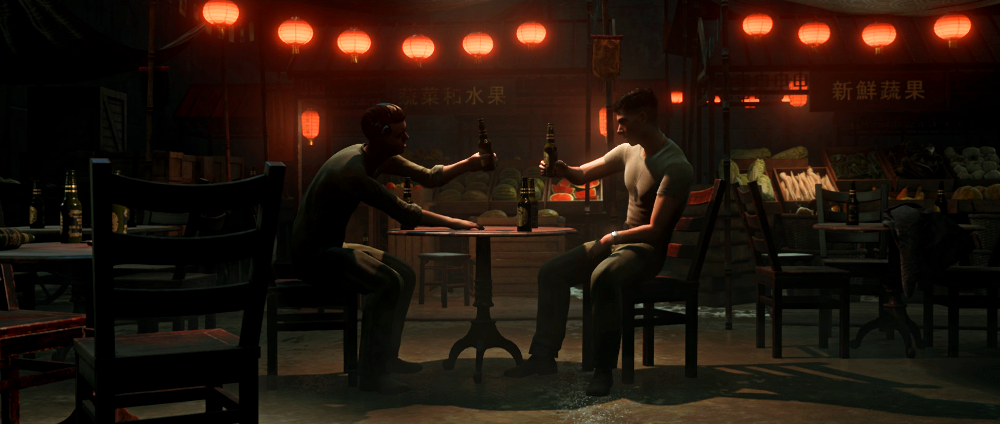
The Benefit of Forewarning
Man of Medan is a fairly interesting experiment of a ghost story that shows its hand. Where Until Dawn perhaps overly invested in its game of whodunit before finally dropping the twist on the heads of its player, Man of Medan is upfront with the inner workings of its narrative. I’d argue that Supermassive wasn’t particularly interested in telling a ghost ship story in the vein of 2002’s Ghost Ship or 1980s Death Ship.
Anyone walking into Man of Medan expecting to spend over eight hours fumbling around with our stock characters without a clue, haunted by malevolent spirits, needs to temper their expectations. As an unsubstantiated tale about a ship whose existence forever remains dubious, Supermassive uses the SS Ourang Medan’s most recognizable elements among the many versions of its myth to create its particular story.
Man of Medan doesn’t require that the player be privy to the myth’s finer details or theories, but it operates on the pretense that the audience has already gone in search of more information on the ship, and understands implicitly from the opening act what exactly occurred when lightning struck the ship and damaged the materials in the cargo hold.
Our young and light-on-common sense horror victims, however, are blind to the events of the ship. I’d go as far as arguing that in the universe Man of Medan inhabits (The Dark Pictures Anthology), there were no accounts of the SS Ourang Medan, no old newspapers and alleged survivors who would perpetuate a myth that is ultimately the reason for the game’s existence.
The Dark Pictures Anthology sees the military somehow cover up the incident and the Medan sailing free and unbothered instead of sunken by an explosion triggered by loose chemicals. Depending on how observant the player is during their unique playthroughs, whoever survives long enough to reach the fairly quick approaching end, they’ll discover memos that eventually lead them to the true meaning of the phrase “Manchurian Gold”.
Can a narrative unfettered by the unknown frighten its viewing and playing audience, as well as a game that obscures so much of its foundation? Well, when most of the scares of your game are comprised of musical stingers (composed by Dead Space’s Jason Graves), loud noises, and jump scares, then the answer is yes. There will be no shortage of moments that will have you jumping out of your seat or leaning away from your television or computer screen.
Man of Medan isn’t without mood or atmosphere, but in a lot of ways, I understand why the characters and audience don’t learn about revelations at the same time. The downside, however, is that Medan is a slog to get through. The buildup to the ship ends up undermined because we were there not moments ago. And once you’re back on the ship with the twentysomethings, you spend most of the game waiting for the characters to catch up to where you’ve been for the last couple of hours.
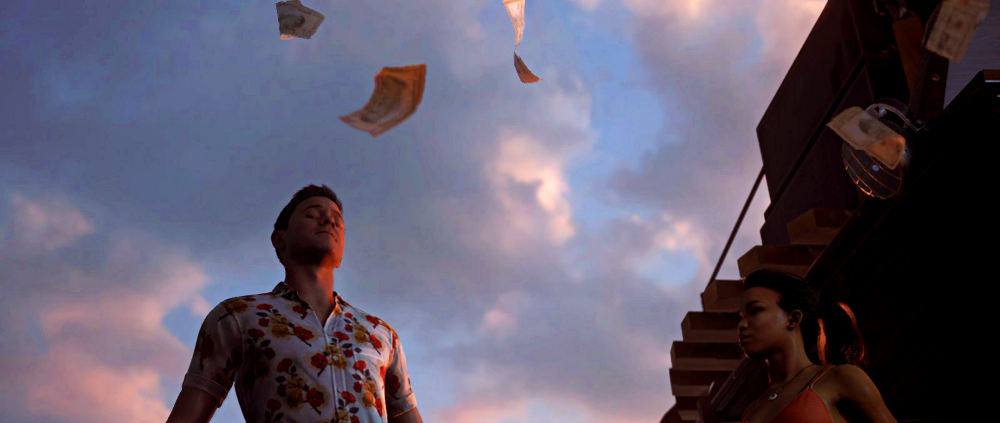
The Downside of Honesty
With the narrative relatively free from playing the magician’s act, one would assume that the screenwriters would take advantage of putting their weight behind the characters with the time they have afforded to them. That is not the case. While there is a clear gap among the cast in terms of screen time, Until Dawn’s character development takes advantage of its length and tries to elevate the cast above the archetypes they’re introduced as.
Because the players know exactly what happened on the ship, Man of Medan’s dedication should’ve been to its characters. Its inability to develop the characters wouldn’t necessarily be negative if it wasn’t for the game’s lack of interest to expound on who the characters are as we’ll ultimately know them.
Where the hallucinations in the prologue are informed by things close to the first player characters, the same can’t be said of the sea diving group of the present. A lot of what they dream up is a consequence of what they see in their present surroundings — dried up corpses and the rusted environment of the ship.
But the hallucinations beyond that reveal nothing about the characters, and the one that stands out like a question mark is probably the Pinup Girl that Conrad hallucinates. I explicitly remember seeing the pinup girl poster situated somewhere behind Conrad, but Conrad himself never laid eyes on it. He didn’t even comment on its presence. So, why was he even hallucinating a Hollywood starlet-turned-corpse woman chasing him if he never saw it in-universe?
The most problematic of the cast is the fishermen. Outside establishing certain characters (Conrad) as racially and culturally insensitive with the flouting of money, the fishermen (Olsen, Junior, and Danny) barely function as characters. They’re just tools to getting the cast to the Medan.
As soon as they are aboard the ship, they’re practically dropped from the plot outside brief reminders they’re a mild threat with the “Manchurian Gold” that drives the characters mad. There was a great opportunity to tell one part of the story from their perspective, but that’s largely ignored. Given that the twentysomethings were already interested in looking for the ‘gold’ and presumably knew where it was (the coordinates of the Medan), the pirates, as a point of conflict, weren’t necessary.
The game’s weakest element is the modified ‘butterfly effect’ system it uses. Through default and alternate responses, the narrative branches show the limitations in the writing of the character dynamics. The multiple endings you can get are abrupt, rushed, and poorly thought out when considering some choices you can make. Characters will appear in areas they were miles away from because certain gameplay conditions require them to be with you.
One example of this is Julia appearing in the flooded cargo hold with Alex when she was with Brad on another part of the ship. In certain cinematics, how a character reacts to a situation (like the death of a party member) will not fit with reactionary dialog spoken not moments ago.
In one instance, Alex accuses Fliss of working with the fishermen to exploit his group for money, and she calls his accusation bullshit. Once they’re on the Medan, he brings up the fact that he accused her of double-crossing them, and Fliss acts like this is the first time she’s heard of this. They constructed the scene like Alex never accused her to her face.
The game completely ignores the relationship dynamics established between characters like Julia and Conrad, who are brother and sister but rarely behave like it outside of brief moments of antagonism. Julia can die a fairly gruesome death, but Conrad’s reaction will be completely omitted in favor of Alex weeping over his fiancée’s body using the same audio loop used for when his brother dies (this game reuses a lot of character animations and audio). Conrad doesn’t get to react to his sister’s death unless Alex is killed.
There’s a similar issue with Alex and Julia’s relationship. We’re meant to be invested in them, but writing barely grazes over their dynamic, offering little beyond vague allusions to the fact that Alex wants to marry Julia. Of the siblings present in the game, Alex and Brad are the only characters who behave as though they’re connected to each other by blood. Their interactions are genuine beyond caustic moments, but writing also goes cold in their dynamic.

The strongest character in the game is, without a doubt, Fliss. Her introduction sets her apart from the uncouth rich kids she has to deal with, and she’s defined through her interactions, which informs her personality. Superstitious, she respects the dead and the sea. She knows how to handle tricky situations better than her charges. The game reinforces her strengths when the group ends up kidnapped and taken aboard the Medan.
Fliss is one of the few characters who remain somewhat composed during her hallucinations and acts as a litmus test against players, who may or may not have learned what to do when the characters become daunted by delusions. When Conrad, Alex, Julia, and Brad interact with Fliss, it’s here that they feel the most human. It’s the only time in the game where it feels like the writers were considerate enough to give the player base a glimpse beyond their archetypes (mostly).
Asshole characters like Conrad merely get by on the charisma and ability of their actors. Here, Shawn Ashmore, who is given little to do besides act the fool in one part of the story, then screams his head off in the next. Were it not for characters like Alex, Brad, and Julia, I would’ve argued he was the weakest character in the game because he contributes so little compared to them. Not unlike Matt from Until Dawn, Conrad ends up feeling superfluous because he can die so easily and little about the story will change in his absence.
Ashmore plays the asshole effortlessly (it’s half his filmography if he isn’t the Nice Guy) and makes ridiculous dialog like “Right on, Bradical. I like the cut of your ship!” and “Son of a Thumb” sounds like a perfectly normal thing to come out of someone’s mouth despite their abnormality. He can’t save poorly written innuendos, though.
There’s too much downtime between character dialog and not enough incidental conversation. Characters accompanying you will wander off, sometimes into corners to look at the wall, or sit on a box and do nothing while you explore the tiny spaces before a cinematic interrupts you. Certain things happen or are observed by the player that go unnoticed by the characters when they shouldn’t be.
They directed character reactions like the end credit sequence in Until Dawn, where none of the cast are speaking to each other but to an off-screen identity. The dialog sequences feel artificial in their construction. They made this even worse by the facial animation, which makes it apparent that the characters are on two different planes of existence in their reactions.
Man of Medan needed a protagonist and co-protagonist. Hidden Agenda gave us Becky Marney and Felicity Graves. With Until Dawn, we had Sam Giddings and Mike Munroe. Because the game proper began with Brad and Alex, their dynamic should’ve been the driving force to solidify the narrative’s focus.
There was such a drum-up about Brad’s fears and his know-how about the shipwrecks, in contrast to his brother’s experience as a novice diver and his general preparedness. I assumed that would’ve figured into the story outside the establishing points, but the two get lost in the wind of one unfortunate event after another, so the game has no authentic voice.
If Man of Medan was just about Fliss dealing with angry fishermen hijacking her boat (Duke of Milan) and dealing with hallucinations brought on by the “Manchurian Gold” aboard the Medan, you would lose none of the bite of the game. The rich kids feel expendable. The fishermen would at the very least have a reason to exist as just antagonists to Fliss.
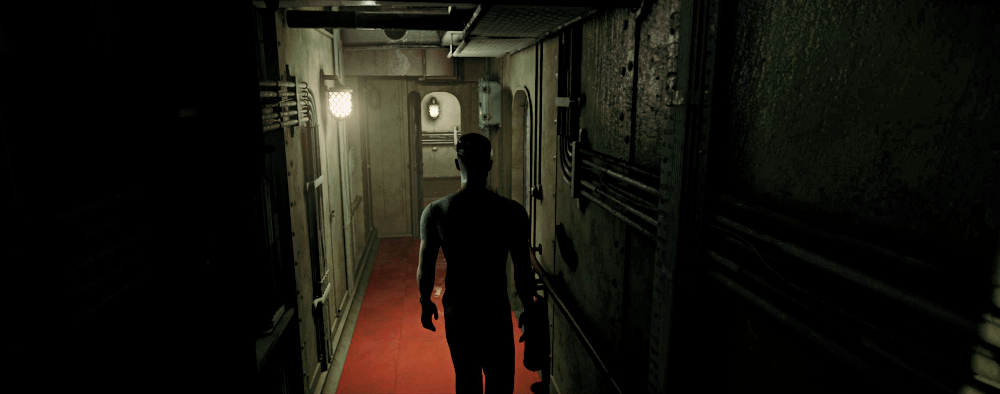
Gameplay
Man of Medan follows the same formulaic gameplay mechanics of Supermassive’s previous ventures, but is thematically tied to the idea that the player choices are aligned to the ‘heart’, to the ‘mind’, or inaction. Quick-Time-Events range from metered to needing the player to be quick on the draw as one prompt flies after the other.
Your character's survival or death depends on how responsive you are under duress. The robotic animations of the characters feed into the feeling that the control scheme is more responsible for the shortcomings of your reaction time. The relative newness of the game at present will probably prove that true more often than not with the bugs and glitches currently in the game. Who knows what’ll get remedied five years down the line with patches, right?
Man of Medan maintains the co-op aspect of Hidden Agenda. Player 1 and Player 2 divvy up the five characters between them, but instead of a split-screen experience, the game cuts itself into chunks that end with a notification screen that tells you when your turn comes up.
If you’ve got an online partner, the experience will differ from the couch co-op experience. From the accounts I’ve read, the player on the other end can see their partner react to nothing in certain cinematics. It’s taking the co-op mechanic from Dead Space 3 and using it to a greater effect.
Supermassive Games is one of the few studios developing games using the fixed camera perspective without a hint of irony or purely to chase a nostalgic high. The ability to take in most of the environment surrounding the character works to set the mood and atmosphere.
From a cinematic perspective, the distance established between the player and the player character creates a kind of voyeuristic dissonance that can create the misleading sense that the characters are being watched by someone offscreen as they wander around the ship.
The limitations of any given level are fairly clear because the camera refuses to change perspective whenever you linger in a corner or try to orient the character around certain areas.
As developers, you know what to expect from a Supermassive game. They’re a budget studio, they don’t receive the funding lesser studios like Quantic Dream get and don’t quite know how to work around their limitations like Dontnod Entertainment does through stylistic art production. The quality of their work shows the seams, tears, patchwork, and shortcuts made to get from Point A to Point B.
Their environment design is fantastic. Idyllic settings like the dock environment and the open waters surrounding the Duke of Milan, and the Milan itself make for some fantastic eye candy. I’m kind of irked that the Milan is so tiny because there’s barely anything to poke at. Everything is closed off behind sealed doors. The underwater environment of the derelict plane, while difficult to navigate, properly encapsulates the awe of haunted exploration that I haven’t experienced since playing Uncharted: Drake’s Fortune.
The claustrophobic design of the post-death Medan is something I wish I could explore unrestrained by narrative choices and baked in events that require the game to progress. Where the prologue of the game merely makes the Medan feel like an empty arena of closed-off areas, the ship in the present feels hollowed out, properly undead and littered with corpses when we’re allowed to return. The mood and atmosphere invoke the right uncertainty in touching anything.
I’m constantly waiting for the superstitious respect that Fliss has for not touching anything in a wreck to haunt every action of characters who don’t share her views, to play into the ghostly atmosphere of the ship of lost souls, yet it never comes.
That most of the characters — save Alex and Julia — are walking around barefoot makes exploring the ship seem perilous despite the plot armor that protects them. For all the lamp-shading the characters do about needing tetanus shots in the aftermath of their misadventures, the game doesn’t play into that paranoia. A rusted piece of plane cuts Julia and nothing happens to her.
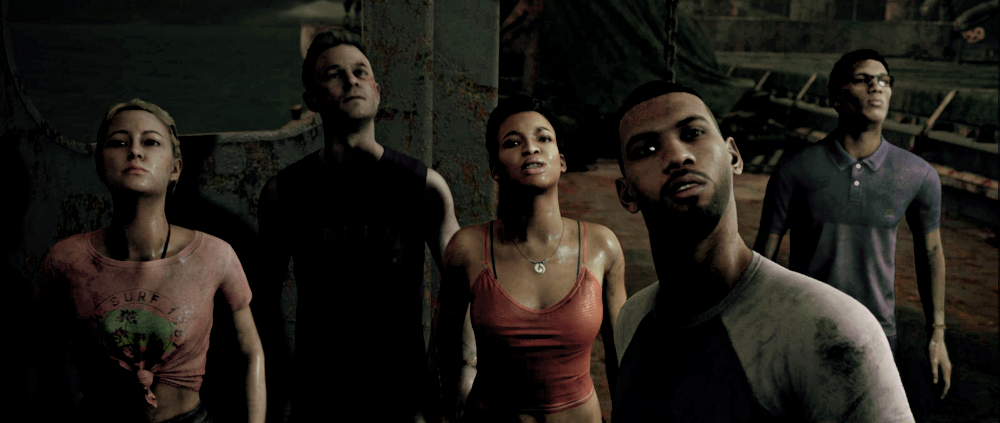
While the environments are fantastic, the same can’t be said of the characters. The cast of Medan trudges through Supermassive’s reliable vineyard of Uncanny Valley, performing like animatronics at the Pirates of the Caribbean theme park ride, gritting their teeth at importune times, which is often accompanied by frozen expressions that break the immersion of any sequence.
Nothing highlights that better than Shawn Ashmore’s mere presence. Three years ago, he starred in Quantum Break, a cinematic third-person shooter with state-of-the-art motion and facial capture tech that recreated his likeness to a T. Supermassive doesn’t have that Microsoft Money or Remedy Entertainment’s super expensive game engine (Northlight), so, in Man of Medan, he looks like an overly smooth, plastic representation of himself.
Supermassive’s love for the horror genre is befitting of the wooden acting of the character models that don’t live up to most of the human performances. Their actors aren’t struggling with their material (mostly). They look and sound the part of character actors you’d see in early-to-mid 2000s horror films. But the animations invoke the feeling of the MTV Spider-Man series, a cel-shaded CG nightmare produced by a dying Mainframe Entertainment. The puppet strings are obvious and it’s hard to ignore them.
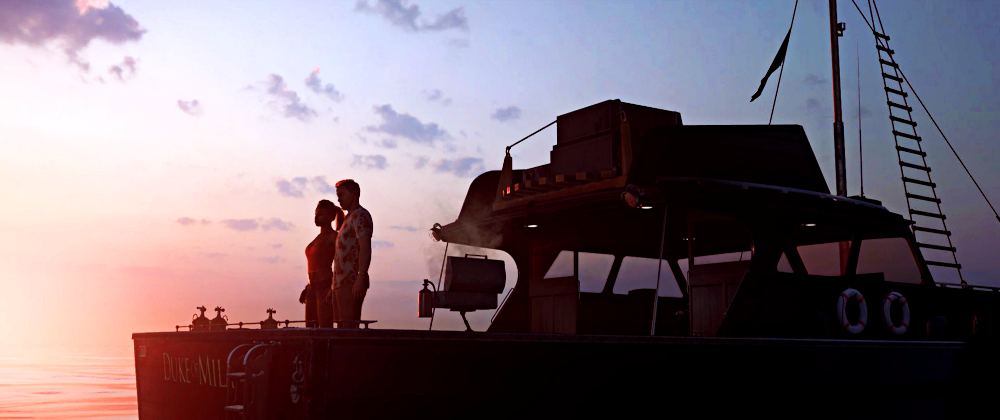
The pre-release preconception of Man of Medan’s premise about a mythical ship lost somewhere at sea convinced me we would get something akin to Digital Happiness’s DreadOut, StoryTale’s Pamali: Indonesian Folklore Horror, or even Red Candle Games’ Devotion or Detention (you should play these games if you can).
I was expecting a full-on physiological horror of Ringu-esque mythology about a group aboard an abandoned ship full of lost and tormented souls prepared to tear them apart for disturbing their resting place.
It is disappointing that it doesn’t turn out to be anything like the aforementioned games. It’s disappointing that there are no actual ghosts, that there is no supernatural element afoot.
Yet, for all the problems that Man of Medan has with its presentation, it remains a fairly admirable, if not jagged-around-the-edges, horror entry in Supermassive Games’ resume of spookiness. Man of Medan is a good time. If you’re not vehemently against jump scares, or mood and an atmosphere that doesn’t feed into supernatural elements, I think the game has a lot to offer.
I sincerely hope this team gets better funding for their games, and that they balance their run-time and narrative structures better. Every single game they’ve released so far (yes, including Until Dawn), while enjoyable in some capacity, always feels hampered by a glaring shortcoming.
I don’t know how the other Dark Pictures games will turn out, but Man of Medan simply reinforces the idea that Supermassive’s games have the potential to be better than what they usually end up being.